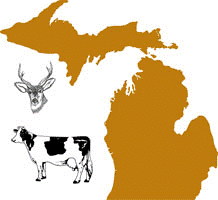Wildlife Disease and Zoonotics
Date of this Version
2010
Abstract
Between October 2005 and May 2006, a total of 727 badgers found dead in Wales were reported, and 550 were delivered to the Regional Laboratories of the Veterinary Laboratories Agency (VLA). Of the 459 carcasses suitable for examination, 55 were deemed to be infected with Mycobacterium bovis on the basis of culture, spoligotyping, and variable-number tandem repeat typing. Acid-fast bacteria were observed histologically in a further six badgers, but these bacteria were not confirmed as M. bovis by culture. A rapid serological test (BrockTB Stat-Pak) performed on thoracic blood showed a sensitivity of 35% and a specificity of 99%. Presence of M. bovis infection was 45 times more likely to be confirmed postmortem by culture in BrockTB Stat-Pakreactive animals than in seronegative ones. Using visible carcass lesions as a marker of bovine tuberculosis (bTB) infection had a similar sensitivity (38%) but was significantly less specific (84%) than serology. The overall accuracy of the antibody detection was 93% (346 correct results from 374 tests), whereas the accuracy of regarding visible lesions as a marker for bTB infection was 78% (354 correct from 453 carcasses examined). Culture remains the gold standard method for detecting M. bovis infection in badgers. However, where resources are limited and/or an instant result is preferred, the BrockTB Stat-Pak could be used in field surveillance efforts to identify animals which should be examined further by only submitting test-negative animals to more detailed postmortem examination and culture.


Comments
Published in CLINICAL AND VACCINE IMMUNOLOGY, Mar. 2010, p. 408–411.